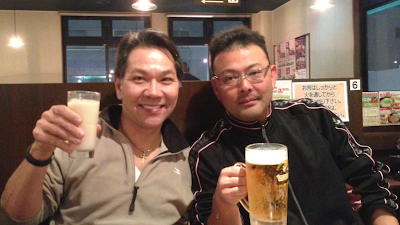Ramen Seiya ラーメン せい家
After the day at Disney, we went to grab a bite to eat a a local Yokosuka ramen restaurant that specializes in one kind of ramen called Tonkotsu Ramen. It is a typical hole-in-the-wall restaurant that seats about 14-16 people at the counter.
It's located at:
せい家 - Sei-ya Ramen / Noodle House
大矢部2-6-23 横須賀市, 神奈川県 (Oyabe 2-6-23 Yokosuka, Kanagawa Prefecture)
Google Maps Link: http://goo.gl/maps/09oFG
Orders are placed via a machine by the front door to the right as you go in and since they only serve one kind of ramen, the choices are from a regular or large bowl of ramen and then all of the assorted toppings that you might want on/in your soup.
Black pepper, white goma, toban jiang, ninniku-dare, my gyoza and bowl of Tonkotsu Ramen
We all chose to have cabbage, chashu, spinach and boiled eggs (Japanese-style boiled eggs have thick liquidy yolks) on top of our bowls of ramen as well as the typical side order of pork gyoza.
Seiya's AMAZING bowl of Tonkotsu Ramen
The soup was nothing short of amazing and as soon as the bowls were handed to us by the chef, we were noisily slurping away in delight. In Japan, to eat a bowl of ramen quietly is to truly insult the chef and you will definitely get stared at (surreptitiously, of course) by the diners around you at your gross rudeness. Just an FYI if you go out for ramen in Japan - anywhere.
This is a smile only a bowl of 'porky pork' pork tonkotsu ramen can induce!!
Fresh, handmade ramen - not quite the fried, dried cup noodle variety.
Typical Ramen Toppings - but there are much more than on this list....
Chashu is made by simmering pork belly with garlic, ginger, sake and shoyu. 'Char-siu', Chinese barbecued pork, became Japanese simmered pork: chashu. Like ramen itself, it originated in China but evolved into a favorite Japanese recipe and is different than the Chinese version.
Menma is prepared by simmering dried bamboo shoots in the broth from making chashu. The broth is sweetened with mirin.
Ninniku-dare , garlic paste, is a condiment often served with ramen. It’s made by blending pork fat and garlic in a food processor then heating it to cook a golden color.
Toban jiang, Japanese chili-bean sauce, is another common condiment. You can purchase this in many Asian grocery stores.
Nori Japanese roasted seaweed or laver can be cut into rectangles, triangles or narrow strips.
Negi, Japanese long green onion, is often cut into thin rings and there is also negi with ra-yu, a Japanese chili oil which is often eaten with gyoza or Chinese foods.
Eggs are often hard-boiled and sliced. Tiny quail eggs might be served whole. Sometimes the eggs are cooked as a thin omelette then cut into julienne and occasionally the eggs are served onsen-style which means 'hot-spring' eggs so the are barely poached.
Naruto is a fish cake with a pink spiral that becomes visible when it’s sliced thinly.
Bean sprouts can be stir-fried or blanched to add to a bowl of ramen.
Cabbage can be chopped or shredded and stir-fried.
Corn is a real typical ramen topping and butter is often added with the corn.
Kimchee can be served as a topping or as a side dish.
Plain rice, stir-fried rice, or curry rice may be served as side dishes with ramen, and often, people like to have gyoza to accompany their bowls of ramen.
Tonkotsu Ramen is a special ramen where the soup stock is laboriously made from long-simmered pig trotters and bones. I have made it before myself and it is a silky, pure white unctuous broth that is just delicious! Of course, it has to be made correctly. For a GREAT, detailed recipe, take a look at:
http://www.seriouseats.com/2012/02/how-to-make-tonkotsu-ramen-broth-at-home-recipe.html
If you don't want to go through the effort, there is, however; a MUCH easier way to enjoy Tonkotsu Ramen inside and outside of Japan if you aren't in the Yokosuka area to go to Seiya Ramen.
Just go to one of the 43 Ippudo restaurants in Japan (http://www.ippudo.com/index.html) or the one in New York City at 65 Fourth Avenue (http://www.ippudony.com/) and try a bowl of Heavenly Porky Deliciousness! They really have perfected a wonderful version of Tonkotsu Ramen. There are also Ippudo locations in Singapore, Seoul, Hong Kong, Taiwan, Shanghai and Sydney. There are also Ippudo locations in Singapore, Seoul, Hong Kong, Taiwan, Shanghai and Sydney.
Ippudo's Tonkotsu Ramen
So if you need a bowl of Japanese soul food, comfort food then give Tonkotsu Ramen a try!!































.JPG)






















